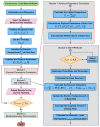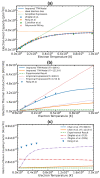Atomistic-Continuum Study of an Ultrafast Melting Process Controlled by a Femtosecond Laser-Pulse Train
- PMID: 38204038
- PMCID: PMC10779960
- DOI: 10.3390/ma17010185
Atomistic-Continuum Study of an Ultrafast Melting Process Controlled by a Femtosecond Laser-Pulse Train
Abstract
In femtosecond laser fabrication, the laser-pulse train shows great promise in improving processing efficiency, quality, and precision. This research investigates the influence of pulse number, pulse interval, and pulse energy ratio on the lateral and longitudinal ultrafast melting process using an experiment and the molecular dynamics coupling two-temperature model (MD-TTM model), which incorporates temperature-dependent thermophysical parameters. The comparison of experimental and simulation results under single and double pulses proves the reliability of the MD-TTM model and indicates that as the pulse number increases, the melting threshold at the edge region of the laser spot decreases, resulting in a larger diameter of the melting region in the 2D lateral melting results. Using the same model, the lateral melting results of five pulses are simulated. Moreover, the longitudinal melting results are also predicted, and an increasing pulse number leads to a greater early-stage melting depth in the melting process. In the case of double femtosecond laser pulses, the pulse interval and pulse energy ratio also affect the early-stage melting depth, with the best enhancement observed with a 2 ps interval and a 3:7 energy ratio. However, pulse number, pulse energy ratio, and pulse interval do not affect the final melting depth with the same total energies. The findings mean that the phenomena of melting region can be flexibly manipulated through the laser-pulse train, which is expected to be applied to improve the structural precision and boundary quality.
Keywords: femtosecond laser; laser-material interaction; molecular dynamics; two-temperature model; ultrafast melting process.
Conflict of interest statement
The authors declare no conflict of interest.
Figures














References
-
- Sugioka K. Progress in ultrafast laser processing and future prospects. Nanophotonics. 2017;6:393–413. doi: 10.1515/nanoph-2016-0004. - DOI
Grants and funding
LinkOut - more resources
Full Text Sources

